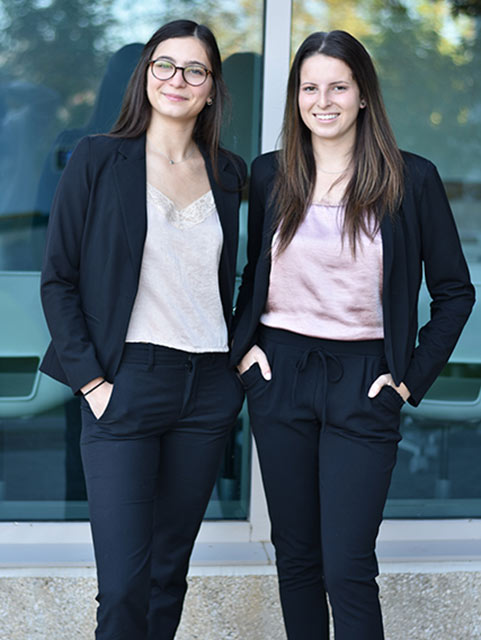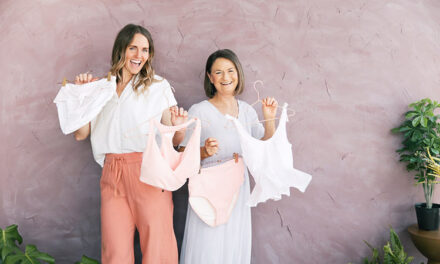Young Women Get Business Fashion Help from Two of Their Own
The founders/owners of Ready Dress Go are their own sales demographic
By Ed Goldman
Two juniors at Vanderbilt University are on a mission from Mod. They mean to make it possible for women their own age—as well as those a bit younger and some a bit older—to garb themselves for success with their self-designed (and cleverly named) age-appropriate fashion line, Ready Dress Go.
“We’re targeting young professional women 18 to 24 years old,” says Zoe Antell, co-founder with Jessica Kaplan of the online company, which is taking pre-orders before its spring launch (after what the partners call a “soft” opening—a term usually used in the restaurant business, but either way, we’re talking about consumers).
Zoe Antell, left, and Jessica Kaplan
Antell is 20 and Kaplan will be 21 five days from now, making them their own targeted demographic. Both say they’ve been into fashion since before they can remember.
Antell is a New York City native whose late mom, Bain Antell, worked in sales and store management for Ralph Lauren and Donna Karan. Zoe is related to me through a cousins network too exhausting for me to contemplate, but one that must be credited for my meeting her on a Zoom call this past Thanksgiving—set up by my indisputably first cousin, Marcia Antopol, president of the Los Angeles-based philanthropical institution Fineshriber Family Foundation.
Kaplan, from Chicago, says, “I always loved sketching as a kid—and I watched a lot of ‘Project Runway.’” (That show, for the uninitiated, has now been on the air for almost 17 years.) As she puts it, from the moment she got her first fashion sketchbook, “I knew that designing outfits was in my future.” More: Jess loves all things yoga- and spreadsheet-related, a combo that inspires me to feel she’ll know how to stretch a budget.
While the two entrepreneurs knew what they wanted to create, they also knew what they didn’t have either the aptitude or, more likely, the patience for: manufacturing. With a wisdom beyond their years, as it’s said (usually when it’s true), Antell and Kaplan researched and interviewed 15 potential manufacturers, coming to rest on a nearby designer, Megan Prange, who has her own Prange Apparel line of women’s fashions.
“We clicked personally,” Antell says, with Kaplan adding, “And she was a very short drive away from the school.”
Vanderbilt, as you probably know, is in Nashville—and while it’s best known as the country music capital of the known galaxy, it’s also, as the state capital of Tennessee, a cosmopolitan and business-oriented city. Amazon, Bridgestone, Nissan and Cracker Barrel Old Country Store all have corporate HQs there. And for now, so does Ready Dress Go.
As recaptured in a story by student journalist Jaime Svinth, the superhero origins of Ready Dress Go include the founders—“haunted” by the complaints that most women’s pantsuits, considered de rigueur in business fashion, were constructed of “itchy fabric”—obtaining a $2,000 grant from Vanderbilt’s highly regarded Owen School of Management and $2,300 from the Wond’ry (Vanderbilt’s Center for Innovation and Design) “in hopes of bringing the comfort and fashion of business attire to young women across the country.”
Kaplan told the young reporter that she and Antell had been complaining—after being “bombarded with networking events, information sessions and a variety of business functions” that required them to dress professionally—“about the lack of options for young women who are going to their first interviews or jobs….
“On one of these conversations, on our walk back to Commons one day, Zoe turned…and said, ‘Why don’t we do something about this?’”
As the story made clear—and Antell and Kaplan recapped for me—the conversation led to the new partners interviewing “30 different women” about their own experience in shopping for and buying business outfits. The business school had taught them the value (and necessity) of doing their homework before creating a business.
The two are planning the “soft launch” of “a small set of inventory,” Antell tells me, “probably in late winter.”
If you are or know a young woman who could use a stylish leg up as she begins her professional life, you might want to encourage her, sooner than later, to check out Ready Dress Go. I thank you—and my no-longer distant cousin thanks you.
Dear Readers: I make my annual pilgrimage to PBS's "Studio Sacramento" this week. Watch me if the Ambien isn't kicking in:
Ed Goldman's column appears almost every Monday, Wednesday and Friday. A former daily columnist for the Sacramento Business Journal, as well as monthly columnist for Sacramento Magazine and Comstock’s Business Magazine, he’s the author of five books, two plays and one musical (so far).
Yes, Virginia
A Weekly Blog by Virginia Varela
President and CEO, Golden Pacific Bank
photo by Phoebe Verkouw
Keep it simple, sweetie, (my kinder, gentler version of what the K.I.S.S. usually means—Keep It Simple, Stupid) should apply to government programs. But they shouldn’t be so simple that they allow fraudsters to take advantage. Apply that to PPP and you have yourself a deal.
For example, keep the applications streamlined and simple, making it more understandable for the smaller borrower. But make the eligibility criteria tighter than “I’m being negatively harmed by the pandemic.” Who isn’t?
Unfortunately, the first round of PPP was abused by some. The rules were too relaxed or confusing, so we continue to hear sad tales of PPP recipients that didn’t need the funding but grabbed it anyway by taking advantage of lax and/or confusing standards. The little guys—like your favorite locally owned coffee shop or your hairdresser down the street that really, really needed the funds—may not have been quick enough or connected enough to get PPP funds.
The second round of PPP is more organized, and ironically the applications more streamlined. Off to a better start, but still the old adage may apply, keep it simple, sweetie (but not too simple.)
sponsored content














